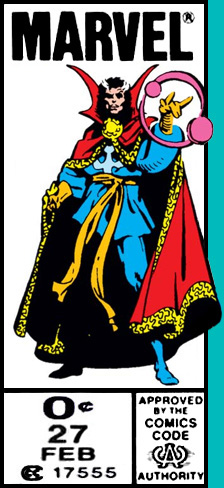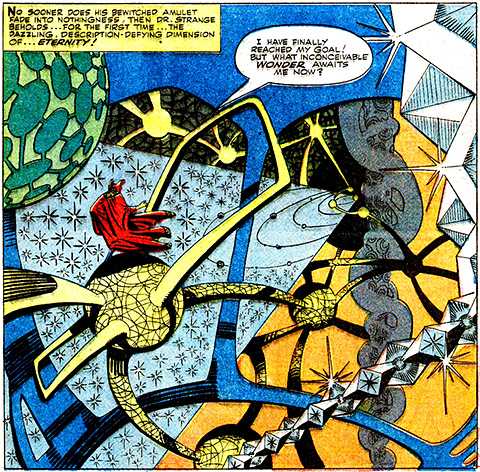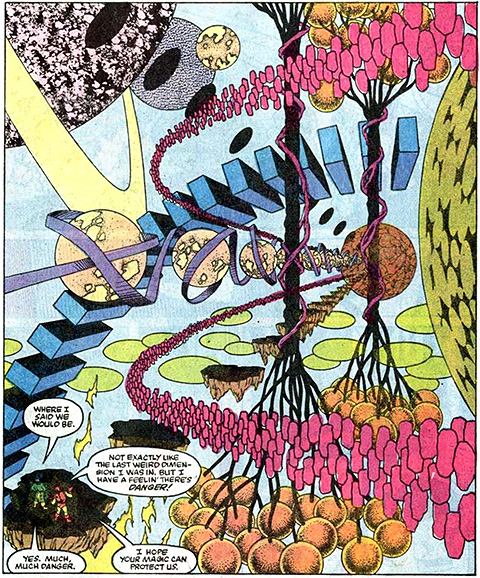

Stan Lee, Steve Ditko, [Jean Thomas,] Jon Spaihts, Robert Cargill, and Scott Derrickson, 2016
If Fantastic Four #1 was the Big Bang of the Marvel Universe, then 1963 was its inflationary epoch, with Stan Lee tossing out as many superhero concepts as the company’s publishing schedule had room for, and finding that most of them were sticking. That year, Stan related, Spider-Man artist Steve Ditko came to him with a new concept with “sort of a black magic theme”, and Stan dubbed the lead character “Doctor Strange”, having forgotten that he’d just bestowed that name upon an Iron Man villain. This new Doctor Strange was a haughty magician with heavy-lidded eyes and some odd points to his eyebrows and mustache, and Stan seemed skeptical about his chances to catch on: he deemed Strange’s first story “filler” and “nothing great”, and shoved it into the back of the Human Torch’s solo book, after a story about telepathic cavemen. And yet that first story contained much of the Doctor Strange mythos: the Greenwich Village sanctum with its distinctive window, Wong, astral forms, the Ancient One, the villain Nightmare, and the Eye of Agamotto. Not too shabby for a story that ran a grand total of five pages!
Doctor Strange was actually an ideal character for both of his creators. Under Stan Lee’s pen, any character could do anything—Hawkeye could lift a ton of iron via archery “by vibrating the arrow at the correct frequency pitch”, Captain America could hypnotize monsters by twirling his shield, you name it—and now Stan had a hero whose power really was to do anything. Plus, he got to sprinkle his dialogue with nonsense like “I swear by the twelve moons of Munnopor” and “Let the hoary hand of Hoggoth guide my attack!” As for Ditko—Doctor Strange was a character who spent much of his time in abstract netherworlds like this:

This seems like a good fit for a guy who drew superheroes to pay the rent, but whose passion was drawing comics that looked like this:

Legend has it that hippies from the underground comix scene would turn up at the Marvel offices wanting to meet the acid fiend turning out this psychedelic art, only to find a guy in a gray suit and military haircut who was an acolyte not of Timothy Leary but Ayn Rand. This strikes me as a tall tale—that “inconceivable wonder” panel is famous, but I’ve read all the Ditko issues and there aren’t many other panels like it. He generally kept his panels small and the backgrounds blank with maybe a few floating whatsits in the occasional panel. Still, he pointed the way toward a Marvel house style for mystical realms, and other artists ran with it:

Thus, it is probably no surprise that Doctor Strange, the movie, is at its core a showcase for trippy special effects—specifically, special effects right out of Inception, with backgrounds folding in upon themselves and fractally expanding while gravity changes direction willy-nilly. On the level of story, much of the movie is kind of lacking, but that’s not a huge surprise because the same is true of the source material. Once the letters had come in on the first two five-page Doctor Strange stories, Stan decided to run with the character, and his fourth appearance began thusly:

But Doctor Strange’s origin is, to be generous, half-baked. We learn that Stephen Strange (now drawn with eyes, eyebrows, and a mustache that don’t stand out from those of Ditko’s other characters) was once the top man in his field—absolutely brilliant, but money-hungry and arrogant. Then his life took a turn when he was critically injured. (Sound like any other brilliant, arrogant, mustachioed Marvel characters whose lives were transformed by a critical injury?) In Strange’s case, his field was surgery, and the car wreck that nearly took his life left him with nerve damage in his hands that made it impossible for him to return to the operating room. With Western medicine unable to restore his fine motor skills, and desperate for any lead, he heads to the East and locates the master sorcerer known as the Ancient One… but even after having come a very long way, he can’t get past his skepticism and dismisses the Ancient One as a crackpot. Up to this point the movie follows the comic beat by beat, but then they diverge a bit. In the comic, the Ancient One causes the temple to be snowed in, long enough for Strange to become convinced that magic is real and to discover that the Ancient One’s disciple, Baron Mordo, is plotting against the master sorcerer. Strange decides that he must “learn the secrets of black magic” in order to fight on the Ancient One’s side against Mordo, and over the course of years becomes a master sorcerer himself. And, okay, but why would an egocentric asshole suddenly decide that the fight against Mordo took precedence over everything else? Why would the Ancient One decide that this goon who just wandered in off the street should be his new star pupil? And considering the number of other magicians who prove to populate the world, why would it just so happen that Stephen Strange would turn out to be the best at magic?
The movie doesn’t really improve on this. The cinematic Ancient One actually kicks Strange out of the temple rather than sealing him in, and it is Mordo (a loyal disciple in this version) who argues that they “could use a man like Strange”. Why? He’s just a jerk who walked in off the street. In the movie, the Ancient One has many disciples, and while Strange does have a photographic memory that allows him to work through spellbooks at a rapid clip, he doesn’t otherwise seem to be more gifted than any of the other students. At first, he’s worse, and can’t even get a basic portal to work; the Ancient One transports him to Mount Everest as a sink or swim challenge, and that somehow solves the problem. It’s like the koan: if you hatch a goose egg in a bottle and then let the goose grow until it can no longer fit through the neck, how do you get the goose out of the bottle without harming the goose or breaking the bottle? Answer: “…It’s out!” And now suddenly Strange has randomly become the top guy at the school. Huh? The movie skips over the part about how he earns or deserves that pride of place, other than just happening to be the guy on the poster.
That said—despite Stan’s “whoopsie daisy, I plumb forgot to do his origin!”, there’s a reason the first Doctor Strange story had him already in mid-career: like I keep saying about Fantastic Four movies, starting with the origin is often a bad move. The great majority of the best superhero stories take place when the hero is long established, and not too many members of the audience protest, “But how can I enjoy this if I don’t know how all these people got their powers??” And once this movie gets past the origin stuff and just tells a Doctor Strange story, it’s fine. Better than fine—I can think of any number of classic Fantastic Four stories, but when I try to think of classic Doctor Strange stories, I come up with a whole lot of crickets and tumbleweeds. The showdown between Strange and Dormammu at the climax of this movie may actually top my list! It’s clever, cool, and has a logic to it that you rarely get with this character. In fact, I don’t think there’s been a better climax to any MCU movie up to this point, Iron Man included. (And even though I was six years late in getting to this movie, somehow I managed to make it all that time without running into any spoilers. Maybe magic is real!)
 |
 |
 |
 |
||
|---|---|---|---|---|---|
Tumblr |
this site |
Calendar page |
|||